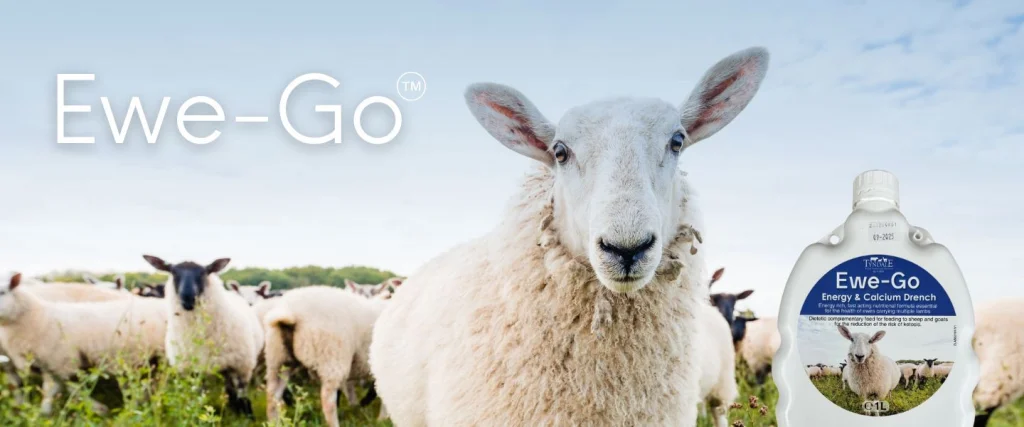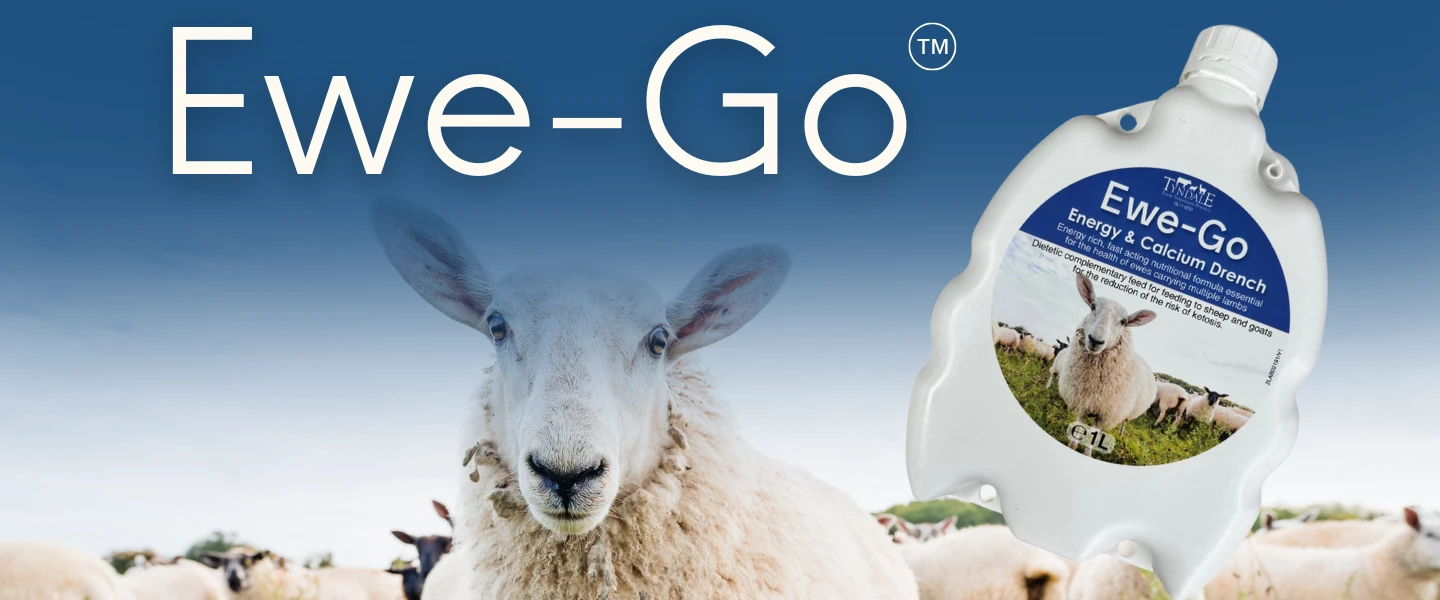Ewe-Go™.
Tyndale’s very own bespoke mix of oral calcium and energy for ewes suffering with Twin Lamb disease.

Ewe-Go™
Ewe-Go™ was formulated by the vets at the practice following a busy lambing season where we were seeing lots of cases of pregnancy toxaemia, more commonly known as twin lamb disease. The current products on the market were not working for us or our farmers. We took time to consider the ingredients used in these other products and formulated our own drench.
The problems we were facing were both twin lamb disease (low blood pressure) and low blood calcium. These are common problems in ewes before lambing and distinguishing between the two can be difficult. Ewes suffering from one problem are likely to be affected by the other to some extent. Therefore we created a drench that would tackle both in one fell swoop and Ewe-Go™ was created.
Ewe-Go™ contains both energy sources and calcium. The energy sources are glycerol and propylene glycol. These are converted to glucose by the ewe meaning all the energy is available to the ewe. Ewe-Go™ also contains calcium chloride as a source of calcium in the gut.
Choose between 1 litre bottle flexi-packs so any drenching gun can be fitted for easy administration or 500ml bottle with a pull up spout.
Dose Rate: 100ml per ewe, daily for 5 days.
For bulk and wholesale orders (boxes of 10 or more) please email jessica@tyndalevets.co.uk
or orders of single bottles can be purchased here

https://youtu.be/UyhM7H2KZ_I?si=3jOsBEAz7bf85Ijy Here is a great video we'd recommend to explain twin lamb.
What does twin lamb disease look like? The signs in the initial stages of the disease can be subtle but are usually recognised by experienced shepherds. A ewe isolating from the flock, or hanging back slightly, should start alarm bells ringing. Going off its feed and not joining the scrum at the trough are also signs and, if left untreated, the ewe will deteriorate, become uncoordinated, wobbly and sometimes go blind. Following this, the ewe will go off her legs, collapse and eventually slip into a coma before dying.
So, why does twin lamb disease progress from mild behavioural changes all the way to death? Ewes in late pregnancy have many metabolic stresses. Around 70% of foetal growth takes place in the last eight weeks of pregnancy. To achieve this rapid growth, lambs require increasing amounts of glucose from their mother. To compensate for this, surely the ewe should be eating for two, or even three. In theory that’s all well and good, but in practice it is not as straightforward. As the lambs grow rapidly inside the ewe, they take up more and more space within the abdomen, space which would usually be occupied by the rumen. This reduction in space leads to a reduction in feed intake and the ewe must produce the glucose needed from internal fat stores. As fat is broken down to produce glucose other substances called ketones are also produced. As ketone levels in the blood rise and glucose levels drop, the brain is effectively starved of glucose, leading to the signs of odd behaviour, wobbliness, eventual coma and death. Reduced feed intake and increased demand for calcium for lamb growth and the start of lactation causes ewes to become low in calcium. Calcium deficiency inhibits the ewe’s ability to produce glucose, exacerbating the twin lamb disease.
What is hypocalcaemia? In its own right, hypocalcaemia is a dangerous condition for heavily pregnant ewes, presenting with similar signs to twin lamb disease. Many ewes suffering from twin lamb disease are suffering from calcium deficiency at the same time. Ewes with twin lamb disease have been found to have increased levels of inflammatory markers in their blood, which further inhibits the ability to produce glucose. This inflammation is thought to be a major contributing factor to the deaths of ewes with twin lamb disease. Studies have shown the addition of a non-steroidal anti-inflammatory drug (NSAID) alongside treatment providing energy sources can increase ewe survival rates by 50%, a finding which mirrors our first-hand experience in veterinary practice of treating these cases.
How can we treat twin lamb disease? The problems presented by twin lamb are threefold: energy deficiency, calcium deficiency and inflammation. The energy deficiency can be corrected by giving glucose, but this only works if administered intravenously. Oral glucose in ruminants is lost in the rumen, as the natural bacteria living in the rumen quickly take any glucose administered orally for themselves, meaning none makes it into the ewe. What we can give orally are glucose precursors, namely propionate glycerol and propylene-glycol. These substances are of little interest to the rumen bacteria, but the ewe can quickly and easily use them to make glucose for herself. Calcium can be given in the form of intravenous or subcutaneous injections of calcium borogluconate, or oral forms of calcium can be administered. While both injectable and oral calcium can be effective, oral is easier to administer and can provide a longer lasting calcium boost to the ewe. Therefore, a combination product such as Ewe-Go™, which provides multiple sources of energy and a calcium supply in one oral product is ideal. Although we would say that wouldn’t we!
The third aspect, inflammation, is easily combatted by NSAIDs. Call the practice to speak to one of our vets.